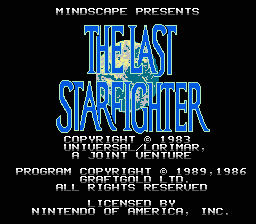Retro Replay Review
Gameplay
The Last Starfighter puts you in the cockpit of an advanced starfighter in a classic side-scrolling shooter layout. Your ship remains centered on the screen while you maneuver forwards and backwards, carefully adjusting your speed to evade incoming enemy fire. The core loop hinges on mastering your throttle and directional controls—learning when to accelerate into combat zones and when to decelerate to dodge tightly packed formations.
One of the standout mechanics is the ship’s ability to collapse into a slimmer configuration. This transformation not only adds a strategic layer—allowing you to slip through narrow asteroid fields and enemy barrages—but also rewards precise timing, as collapsing too early can leave you vulnerable to flanking attacks. Mastering this toggle is essential for disabling the game’s larger starcruisers, which require you to target specific weak points exposed only when your ship is in its compact mode.
Enemy waves approach from all directions, often in intricate patterns that challenge your reflexes and situational awareness. From fast-moving fighters that dart across the screen to heavily armored cruisers that demand sustained fire, each encounter tests a different skill. You’ll need to decide quickly whether to focus on large capital ships or thin out swarms of smaller vessels first—a decision that can dramatically affect your survival.
For those looking to share the action, the two-player mode offers a turn-based alternative. Each player alternates flights against the armada, competing for high scores and bragging rights. While it lacks simultaneous co-op, the alternating structure keeps both pilots engaged, as each death hands the controls instantly to the next player, maintaining a steady rhythm of competition.
Graphics
Graphically, The Last Starfighter embraces the vibrant yet limited palette of mid-80s home computer hardware. Asteroid belts, nebula backdrops, and starfields scroll smoothly to create a convincing outer-space ambiance. Despite the era’s technical constraints, the sense of depth achieved through layered backgrounds and parallax effects remains impressive.
Enemy ship designs exhibit clear silhouettes and color coding that help you distinguish between light fighters, heavy bombers, and capital starcruisers at a glance. Even in the heat of battle, each vessel type is instantly recognizable, which is crucial when you need to prioritize your targets and adapt your collapse-mode strategy accordingly.
The transformation animation for your ship collapsing into a slimmer form is surprisingly fluid and adds visual flair to the gameplay. Subtle particle effects accompany shield impacts and explosions, giving each engagement a sense of kinetic energy. Starcruiser destruction sequences, featuring cascading debris that fades into the background starfield, deliver satisfying visual feedback without overwhelming the action.
User interface elements are kept minimal—HUD indicators for speed, shield strength, and remaining lives are neatly tucked into the screen edges. This unobtrusive presentation maximizes your view of incoming threats while still providing all the vital information needed to survive the armada’s onslaught.
Story
Based on the beloved 1984 film, The Last Starfighter follows the journey of an unsuspecting hero recruited from Earth to defend a distant star system. While the game’s narrative is more of a framing device than a fully fledged adventure, brief intro text and inter-mission messages capture the spirit of the movie, reminding players why they’ve been summoned to the front lines of an interstellar war.
Gameplay sequences are punctuated by short narrative cues that update you on the armada’s progress or celebrate your victories against key starcruisers. Although there are no voiced cutscenes, these textual interludes foster a sense of urgency and purpose, urging you onward as the final line of defense for a beleaguered civilization.
Character development is understandably light—your pilot remains a silent avatar for your actions—but mission objectives tie back to the movie’s core premise: destroy the enemy fleet before it reaches the Rylan Star League’s defenses. Each successful sortie, therefore, feels like a direct contribution to the larger story, even if the details are conveyed primarily through mission stats and brief status updates.
Fans of the original film will appreciate nods to key plot points, from the initial recruitment sequence to the climactic push against the armada’s flagship. Although purists may miss deeper narrative expansions, the game delivers just enough context to keep the stakes high and motivate repeated playthroughs.
Overall Experience
The Last Starfighter delivers a tight, fast-paced shooter experience that captures the essence of its cinematic source material. Its blend of accessible controls and deep strategic options—primarily through ship transformations and target prioritization—offers a satisfying challenge that scales gracefully from novice pilots to seasoned veterans.
While the visual and narrative elements reflect the limitations of its period hardware, the game’s focus on pure, unadulterated arcade action ensures that these constraints never feel like drawbacks. Instead, they contribute to the retro charm, giving players a taste of 1980s sci-fi gaming at its most exhilarating.
Replay value is strong thanks to the pursuit of higher scores, tighter completion times, and flawless runs against each enemy formation. The addition of a two-player turn-based mode further extends the game’s life, providing a competitive twist that rewards both skill and strategy.
For anyone seeking a nostalgically styled space shooter with straightforward mechanics, memorable enemy patterns, and a direct link to a cult classic film, The Last Starfighter remains a compelling choice. Its enduring appeal lies in the simple joy of piloting a starfighter into the thick of cosmic battles—an experience every aspiring Galaxy Defender should sample.
 Retro Replay Retro Replay gaming reviews, news, emulation, geek stuff and more!
Retro Replay Retro Replay gaming reviews, news, emulation, geek stuff and more!









Reviews
There are no reviews yet.